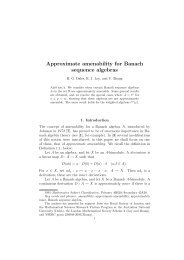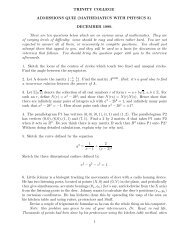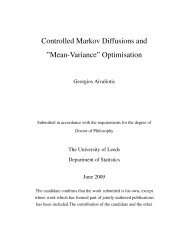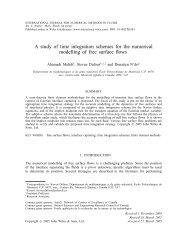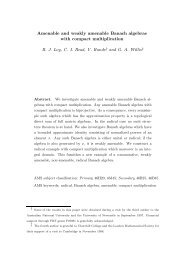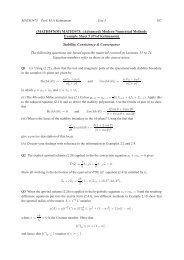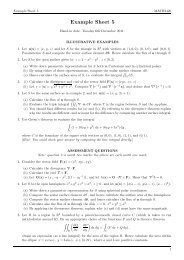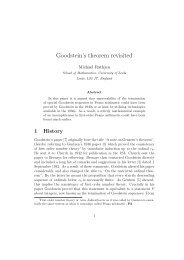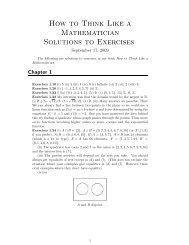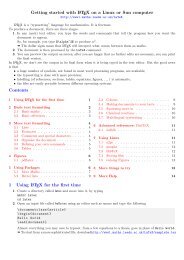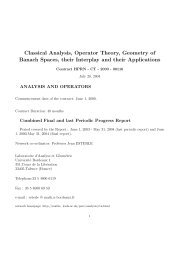MATH 2650 Calculus of Variations Examples 1 The practice ...
MATH 2650 Calculus of Variations Examples 1 The practice ...
MATH 2650 Calculus of Variations Examples 1 The practice ...
You also want an ePaper? Increase the reach of your titles
YUMPU automatically turns print PDFs into web optimized ePapers that Google loves.
<strong>MATH</strong> <strong>2650</strong> <strong>Calculus</strong> <strong>of</strong> <strong>Variations</strong> <strong>Examples</strong> 1<strong>The</strong> <strong>practice</strong> questions (marked P) will be discussed in the <strong>Examples</strong> Classes to be held in Weeks2 and 3. Answers to questions Q1 – Q11 are to be handed in on Wednesday 17 October 2012.P1) Find the general solution <strong>of</strong> the first order ODEs:(a) dydx + y x= sin x, (b) x2dydx + xy = y2 , (c) dydx = x(1 + x2 ) 1/2 tan y, (d) dydx = x2 + xy + y 2x 2 .P2) Find the general solution <strong>of</strong> the second order ODE:d 2 ydx + dy2 dx − 2y = f(x), when (a) f(x) = x + 3, (b) f(x) = sin x, (c) f(x) = ex .P3) f(x, y) = x/(x + y). Calculate ∂ x f and ∂ y f. <strong>The</strong>n show that ∂ 2 xyf = ∂ 2 yxf.P4) Find ∂ x f and ∂ z f iff(x, y, z, w) = (xw) yz .P5) Find all second order partial derivatives <strong>of</strong> f(x, y) = x xy .P6) Using the chain rule, calculate df/dx ifP7) Using the chain rule, calculate df/dt iff(x, y) = 1/ ln(xy) and y = sin x.f(x, y, t) = t 2 + xyt, with x = cos t, y = sin t.P8) Using a Taylor series, express x 3 − 5x 2 + 3x − 6 as a polynomial in (x − 2).P9) Use the method <strong>of</strong> Lagrange multipliers to find maximum and minimum values <strong>of</strong> thefunction f(x, y) subject to the constraint g(x, y) for the following cases:(a) f(x, y) = x 2 + y 2 , g(x, y) = 2x + 3y = 18;(b) f(x, y) = xy, g(x, y) = x 4 + y 4 = 2.P10) Consider a cuboidal coal bunker against a wall. For a given volume V , what dimensionsx, y, z minimise the exposed surface area?P11) By differentiating under the integral sign, calculate the following integral:I(x) =∫ 10t x − 1ln t dt.P12) Find the extremals (ignoring boundary conditions) <strong>of</strong>for each <strong>of</strong> the cases:(a) F = y ′2 − k 2 y 2 ,(b) F = xy ′2 − yy ′ + y.I =∫ x2x 1F (x, y, y ′ )dx
Q1) Find the general solution <strong>of</strong> the first order ODEs:(a) y − 2x dydx = x(x + 1)y3 , (b) dydy+ y tan x = sin x, (c)dx dx = x2 e x3 y 2 ,(d) (x 3 +y 3 ) = 3xy 2 dy , (e) x(x+1)dydx dx = y(x−1).Q2) Find the general solution <strong>of</strong> the second order ODEs:(a) y ′′ +3y ′ +2y = e 4x , (b) y ′′ +4y ′ +3y = cos 3x, (c) y ′′ +2y ′ +2y = e x sin 2x,(d) y ′′ + y = 3e x + e 2x , (e) y ′′ + 25y = sin 5x, (f) y ′′ − 2y ′ − 3y = 2e 3x .Q3) Find all second order partial derivatives <strong>of</strong> f(x, y) = xe xy .Q4) Using the chain rule, calculate du/dt (in terms <strong>of</strong> t) ifu(x, y, t) = t 2 x + xyt + x 3 , x = t 2 + 3, y = t 3 .Q5) Using a Taylor series, express the following as polynomials in (x − 3):(a) x 2 − 10x + 7, (b) x 5 .Q6) Use the method <strong>of</strong> Lagrange multipliers to find maximum and minimum values <strong>of</strong> thefunction f(x, y) subject to the constraint g(x, y) for the following cases:(a) f(x, y) = xy, g(x, y) = x 2 + y 2 = 18;(b) f(x, y) = x + 2y, g(x, y) = x 2 + 2y 2 = 12.Q7) What is the largest rectangle that can be inscribed in the ellipse x 2 + 2y 2 = 1?Q8) Calculate dI/dx, where I(x) is defined as the following integral:I(x) =∫ x 2x1t ext dt.Q9) Find the extremals (ignoring boundary conditions) <strong>of</strong> I = ∫ x 2x 1F (x, y, y ′ )dx for each <strong>of</strong> thecases:(a) F = y ′2 +2y, (b) F = y ′2 +4xy ′ , (c) F = y ′2 +yy ′ +y 2 .Q10) Find the extremals <strong>of</strong>:(a)(b)∫ 10∫ 10(y 2 + y ′ + y ′2) dx subject to y(0) = 0, y(1) = 1;y ′2dx subject to y(0) = 1, y(1) = 2.x3 Q11) Show that, if y(x) satisfies the Euler-Lagrange equation associated with the integral∫ x2(I = p 2 y ′2 + q 2 y 2) dx,where p(x) and q(x) are given functions, then I takes the valuex 1I = [ p 2 yy ′] x 2x 1.



